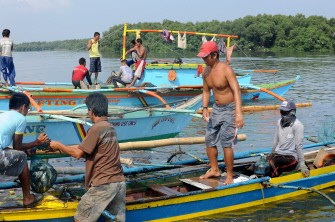MANILA, May 23, 2011 (AFP) - A plan to reclaim land on Manila Bay is ruffling feathers, with conservationists warning the project would destroy one of the Philippine capital's last nature reserves and bird sanctuaries.
Salt marshes, tidal areas and three mangrove-clad islands that make up the 175-hectare (432-acre) zone are a home or a resting spot for dozens of bird species, including the globally-threatened Philippine duck and Chinese egret.

In a sprawling megacity of more than 12 million people that has seen decades of chaotic development, the area known as Coastal Lagoons is vital because there are so few other bird habitats left, environmentalists say.
"It is the last coastal frontier in Metropolitan Manila, the last of its kind," said Rey Aguinaldo, a US-trained biologist who manages the Coastal Lagoons for the environment ministry.
Then-president Gloria Arroyo declared the Coastal Lagoons a critical habitat in 2007, banning activities impeding its ecologically vital role as a bird sanctuary.
But now the government is planning to reclaim another 635 hectares in front of the sanctuary to create a new business centre for southern Manila.
Opponents of the planned 14-billion-peso ($324-million) project fear that although most of the lagoons would initially remain intact, the sanctuary would be left largely cut off from the bay.
"The critical habitat would be penned in, and eventually the mangroves would die because saltwater would not be able to circulate," Aguinaldo said.
"The saltwater mud flats would also eventually dry up."
A highway linking the new business centre with the rest of Manila would also cut through the mangroves, while about 15 percent of one island would be removed for a drainage canal, according to the project's design.
"The road may block the tidal water flow... and thereby dry up the mangrove area and destroy most of the high-tide roosts for waterbirds," said Michael Lu, head of the Wild Bird Club of the Philippines.
But the government's Philippine Reclamation Authority insists the development, which it will carry out with local authorities and a private investor, would maintain the integrity of the habitat.
"The expansion is seaward. No mangroves will be cut," said Josephine Castro, assistant manager for reclamation of the Philippine Reclamation Authority.
Castro also said the authority had revised the original project design so that only ecotourism activities, and no commercial development, would take place in the Coastal Lagoons.
In a twist to the debate, Castro pointed out that the lagoons themselves were on land that was reclaimed from the bay in the 1970s but never developed as originally planned.
"There was no bird sanctuary before. It was due to our activities there that gave rise to the bird sanctuary," Castro said.
Squatters initially colonised the land when it was left vacant, according to Castro.
But she said when it began to sink in the 1980s, the squatters were relocated and the government planted mangroves on the site to stop the water from reclaiming the land again.
Regardless of the site's origins, Lu, the bird club president, warned that the development project would be a final blow for Manila Bay's waterbird population.
"There are no other viable alternatives for the waterbirds anymore," he said.
"More than 95 percent of natural wetland habitats in the bay have been converted to fishponds."
Ornithologists had counted up to 28,000 birds in Manila Bay in a single day in the 1970s, before the fish pond industry exploded and land reclamation began, according to Lu.
That number that is today down to no more than 5,000, Lu said.
He said the 80-strong Manila colony of the Philippine duck would be extinguished if the project went ahead as planned.
Those 80 birds make up nearly two percent of the known population of the species, which is only found only in the Philippines, according to Lu.
He also said the loss of the sanctuary would put further pressure on the rapidly declining global population of Chinese egrets, which spend the northern winter at the lagoons.
The fate of the waterbirds in Manila Bay is a common story across Asia, where habitat has been destroyed at an unprecedented rate in recent decades amid rampant economic development.
Environment monitor Wetlands International reported last year that while strong conservation measures had slowed the decline of waterbird populations in the west, Asian numbers were shrinking quickly.
Habitat destruction was the main reason, with long-distance migrants being the most vulnerable, Wetlands International said.
























